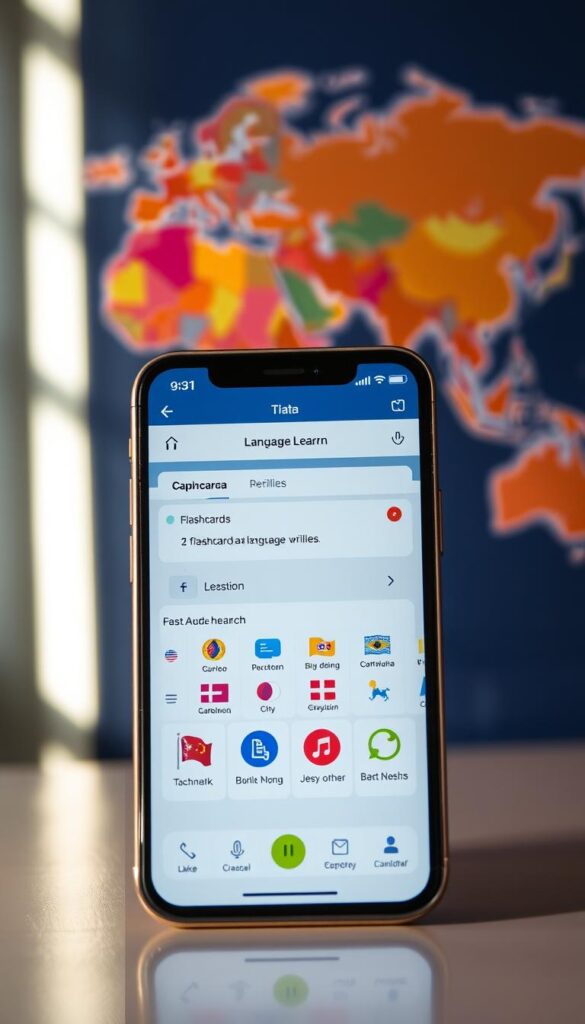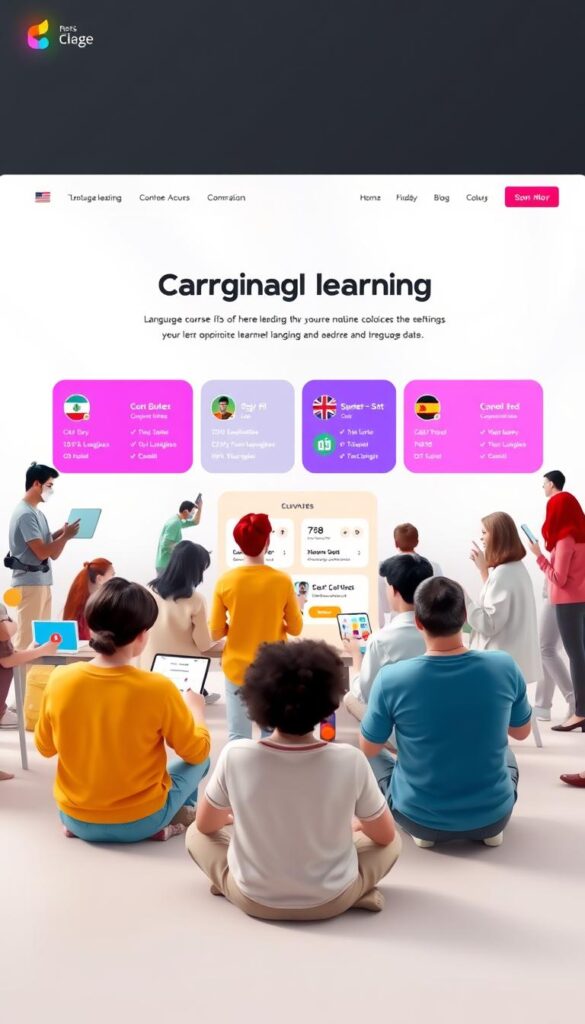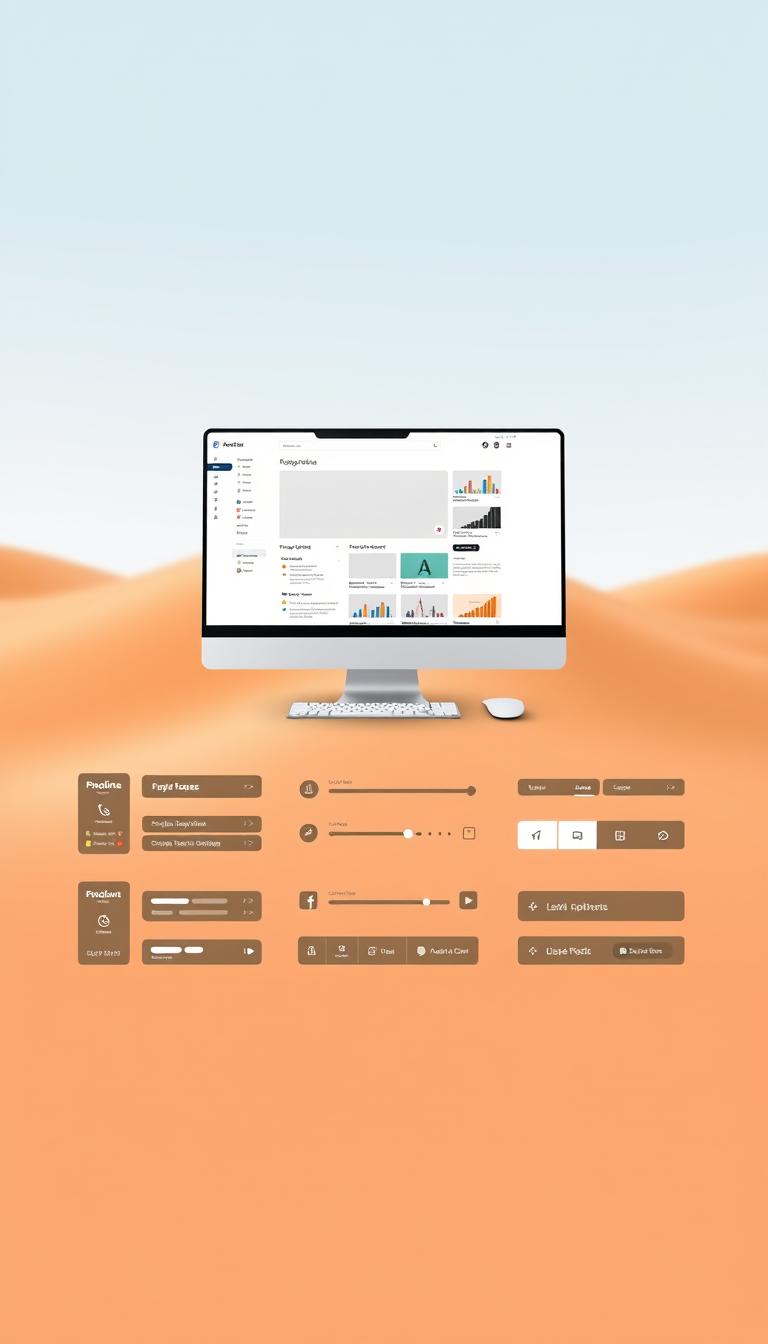
Finding the right language learning platform can be tough. There are so many online language courses out there. It’s key to think about your learning style and goals.
Platforms like Duolingo, Lingoda, and Rosetta Stone are well-known. They each have their own way of teaching language acquisition. But, the best one for you depends on your personal needs and likes.
Knowing what you want to achieve and how you learn best helps. This way, you can pick a platform that fits you well.
Key Takeaways
- Consider your learning style and goals when choosing a platform.
- Popular options include Duolingo, Lingoda, and Rosetta Stone.
- The best platform depends on individual needs and preferences.
- Understanding your goals is crucial for making an informed decision.
- Different platforms offer unique approaches to language acquisition.
What is a Language Learning Platform?
Language learning platforms have changed how we learn new languages. They offer interactive and immersive experiences. These online tools have everything you need to start learning a new language.
Definition and Purpose
A language learning platform helps you learn new languages through fun and engaging content. Busuu, a well-known platform, offers interactive courses created by experts. It also has immersive speaking practice and a global community of learners.
The main goal of these platforms is to make learning languages easy, convenient, and effective.
Key Features
Language learning platforms have many features to improve your learning. Some of the key features include:
- Interactive lessons and quizzes
- Gamification elements to boost engagement
- Virtual classrooms for real-time interaction
- Personalized feedback and progress tracking
- Access to a community of learners for support
These features help create an immersive and engaging learning environment. They cater to different learning styles and preferences. By using technology, these platforms make learning a new language effective.
Benefits of Using a Language Learning Platform
Language learning platforms are now a big deal because they’re easy, affordable, and full of resources. They let learners get top-notch language education from anywhere in the world.
Convenience and Flexibility
Using a language learning website is super flexible. You can learn at your own speed, anytime, and from anywhere. This is great for people with tight schedules, as it lets them fit learning into their day.
Duolingo, a top language app, is free and works on many devices. This means you can keep learning during your commute, breaks, or any spare time.
Cost-Effectiveness
Language learning platforms are often cheaper than classes. They offer good deals, including free versions or trials. This makes learning a language more open to more people.
Looking at prices, we see many options. For example, a table showing the prices of popular platforms could look like this:
| Platform | Free Version | Premium Plan | Annual Cost |
|---|---|---|---|
| Duolingo | Yes | Duolingo Plus | $83.88 |
| Rosetta Stone | No | Rosetta Stone Unlimited | $199.95 |
| Babbel | Limited | Babbel Premium | $129.45 |
Access to Resources
Virtual language classes and websites have lots of tools, like interactive lessons and quizzes. They help learners find what works best for them.
Also, many platforms have extra stuff like podcasts, blogs, and forums. These add a lot to the learning experience.
Popular Language Learning Platforms
The world of language learning has changed a lot thanks to many platforms. Each one offers special features and benefits. Some language learning apps stand out because of their wide range of options and new ways of teaching.
Let’s explore some of the most popular choices:
Duolingo
Duolingo is a top language learning app that’s free and comprehensive. PCMag praises it for making learning fun through games and interactive lessons.

Rosetta Stone
Rosetta Stone is famous for its interactive lessons that feel like real conversations. It’s a paid service that gives you feedback and a clear learning path.
Babbel
Babbel focuses on talking skills, offering lessons that fit your pace and needs. It covers grammar, vocabulary, and how to pronounce words correctly.
Memrise
Memrise is known for its user-made content and a wide variety of courses. It uses games and spaced repetition to help you learn.
Each platform has its own strengths, like interactive lessons or personalized feedback. The right choice depends on what you like and what you want to achieve.
How to Choose the Right Language Learning Platform
Choosing the right language learning platform is important. Today, digital language resources are easy to find. They offer many online language courses for different learning styles and goals.
Assessing Your Learning Goals
First, think about what you want to achieve. Are you starting from scratch or improving your skills? Knowing your level and goals helps you choose the right platform.
Think about why you want to learn a new language. Is it for travel, work, or fun? Each platform meets different needs, so knowing your reasons helps narrow your search.
Comparing Features and Pricing
After setting your goals, compare different platforms. Look for ones with interactive lessons, personalized feedback, and flexible pricing.
For example, Busuu offers interactive lessons and feedback. They say, “Our platform makes learning a language fun and effective.”
“The key to successful language learning is finding a platform that fits your learning style and goals.” –
When looking at prices, check if there’s a free version or subscription. Some platforms offer discounts for long-term plans or extra features.

⭐️ Tap the exclusive deal link https://temu.to/k/uot8tcxvwum to score top-quality items at ultra-low prices. 🛍️ These unbeatable deals are only available here. Shop now and save big! ⭐️ Directly get exclusive deal in Temu app here: https://app.temu.com/m/mhb5rstagbx
Another surprise for you! Click https://temu.to/k/uag0bn0o0wd to earn with me together🤝!
- Evaluate the platform’s user interface and user experience.
- Consider the availability of mobile apps for on-the-go learning.
- Look into the community features, such as discussion forums or language exchange partners.
By carefully looking at your goals and comparing platforms, you can choose the best one. This will help you learn a language effectively and enjoyably.
User Experience: Interactive Learning
Interactive learning has changed how we learn new languages. It makes learning fun and engaging. Many language learning apps now use this method to improve the user experience.

Gamification in Language Learning
Gamification is key in interactive learning. It adds features like points, badges, and leaderboards to make learning fun and competitive. Duolingo, for example, uses gamification to make learning fun and engaging, which has made it popular.
Using gamification keeps learners motivated and practicing regularly. It turns learning into an exciting experience, not just a chore.
Community and Social Learning
Community and social features are also important in interactive learning. Language learning apps that let users connect with others offer a supportive space. Here, learners can practice their skills and get feedback.
- Discussion forums for asking questions and sharing knowledge
- Social media groups for community support and interaction
- Language exchange programs to practice with native speakers
These features help learners not just in language skills but also in building a network. They connect with others who have similar interests.
By mixing gamification and community learning, language apps offer a full and engaging experience. This interactive way is essential for making language learning fun and effective.
The Role of Technology in Language Learning
Technology has changed how we learn languages. It offers new ways to study languages. Digital tools and platforms have made learning easier.

When it comes to learning languages, there’s a choice between mobile apps and desktop platforms. Mobile apps let you learn anywhere, anytime. They’re great for busy people. On the other hand, desktop platforms offer more detailed lessons and exercises.
Mobile Apps vs. Desktop Platforms
Apps like Duolingo and Babbel are popular for their ease of use. They have short lessons that fit into your day. Desktop platforms, however, have more in-depth content for those who want to dive deeper.
Being able to use both mobile and desktop platforms is a big plus. It lets learners choose what works best for them.
Artificial Intelligence in Learning
Artificial intelligence (AI) is becoming key in language learning. AI tools give personalized feedback on pronunciation, grammar, and vocabulary. They adjust lessons to match your skill level, keeping you challenged but not too hard.
AI makes learning more efficient and effective. It tailors lessons to fit each learner’s needs and abilities.
In summary, technology has greatly improved language learning. It offers digital tools and platforms that make learning easier. As technology advances, we can expect even better learning experiences.
Course Offerings: A Closer Look
When looking at language learning platforms, it’s important to check their course offerings. This includes the variety of languages, levels from beginner to advanced, and any special courses or certifications.
Beginner to Advanced Levels
Many platforms offer courses for all levels of learners. For example, Rosetta Stone has courses from beginner to advanced. This helps learners build on their skills and get a strong foundation in the language.
Rosetta Stone says, “Our platform has courses for all levels, including beginner, intermediate, and advanced. This lets users learn at their own pace.” This is great for those who like to learn on their own.

Specialized Courses and Certifications
Some platforms also have specialized courses and certifications for specific needs or goals. For instance, there are business language courses to improve professional skills in a global setting.
Let’s compare some popular platforms to see the variety of specialized courses:
| Platform | Specialized Courses | Certifications |
|---|---|---|
| Duolingo | None | No |
| Rosetta Stone | Business Language | Yes |
| Babbel | Conversational Skills | No |
As more people need language skills in different fields, these specialized courses and certifications are becoming more valuable.
“The key to successful language learning lies in consistent practice and exposure to real-life contexts. Specialized courses can significantly enhance this process by tailoring the learning experience to the individual’s needs.”
Language Learning for Different Age Groups
Learning a new language is a lifelong journey. Today, there are many resources for learners of all ages. Whether you’re young or an adult, you can find something to help you learn.
Language learning platforms now cater to different age groups. Kids get interactive games and fun lessons. Adults can choose more structured courses.
Platforms for Kids
Duolingo is a hit for kids learning languages. It uses games to make learning fun. PCMag says Duolingo is great for all ages, including kids.
Key features for kids include:
- Interactive games and activities
- Engaging lessons with animations and visuals
- Reward systems to motivate young learners
Here’s a table comparing popular platforms for kids:
| Platform | Age Range | Key Features |
|---|---|---|
| Duolingo | 4+ | Gamified learning, interactive exercises |
| Rosetta Stone | 5+ | Structured lessons, speech recognition technology |
| Babbel | 10+ | Comprehensive courses, interactive lessons |
Tools for Adults
Adults can find structured courses to learn a new language. Many platforms offer courses for adults. They focus on speaking, grammar, and vocabulary.
Adults can also try virtual language classes. These classes let you practice speaking with native speakers. Experts say virtual classes are great for improving your skills.
“The key to successful language learning is consistent practice and exposure to the language. Virtual language classes can provide adults with the opportunity to engage in conversations and receive feedback from instructors.”
When picking a platform as an adult, think about these things:
- Course structure and content
- Opportunities for practice, such as virtual language classes
- Flexibility to learn at your own pace

Real-Life Applications of Language Skills
Learning a new language can change your life in many ways. It can make traveling better and help you get ahead in your career. It’s not just about learning words and rules. It’s about opening doors to new experiences.
Traveling Abroad
Traveling to new places is more fun when you can speak the local language. You can talk to people, read signs, and understand the culture better. A language immersion program can really help you get into the local way of life.
Tools like translation apps and language learning sites are great for travelers. They help you get around and communicate with locals. Busuu, for example, prepares learners for real-life conversations, making travel easier and more fun.

Career Advancements
In the job world, speaking multiple languages is a big plus. It can lead to new job opportunities, especially in big companies or fields like tourism and diplomacy. Employers want people who can talk to clients and colleagues from different countries.
| Industry | Benefits of Language Skills |
|---|---|
| International Business | Enhanced communication with global clients and partners |
| Tourism | Better interaction with tourists, improving customer service |
| Diplomacy | Effective negotiation and communication in international relations |
In summary, language skills are very useful in everyday life. They make traveling more enjoyable and can help you succeed in your career. By using digital language resources and joining a language immersion program, you can open up new possibilities for yourself.
Measuring Your Progress
Tracking your progress is key in language learning. It keeps you motivated and helps you adjust your learning plan. Many platforms offer tools to help you see how far you’ve come.
Tools for Tracking Learning
Apps like Duolingo use gamification to keep you going. They have quizzes, exercises, and charts to show your progress. These tools help you see where you need to work harder.
![]()
Importance of Regular Practice
Regular practice is vital for learning a language. It strengthens new skills and boosts your confidence. Staying consistent helps you make steady progress towards your goals.
Regular practice not only boosts your language skills but also makes learning more fun. It lets you use what you’ve learned in real life. This makes learning more meaningful and interesting.
Common Challenges in Language Learning
Learning a new language is often tough. Learners face many hurdles that slow them down. Two big challenges are losing motivation and struggling with pronunciation.
Overcoming Motivation Dips
Keeping motivated is key to learning a language well. Interactive language learning sites help a lot. For example, Busuu gives personalized feedback and support.
By adding fun elements and community help, learners can stay motivated. This way, they can keep moving forward.

Dealing with Pronunciation Issues
Pronunciation is hard to get right, especially for beginners. Language education sites with speech recognition tech help a lot. They let learners practice and get better at speaking.
Getting instant feedback helps learners sound more natural. Interactive lessons and exercises make learners more comfortable with the language’s sounds and rhythms. This approach improves pronunciation and boosts language skills overall.
Future Trends in Language Learning Platforms
The world of language learning is changing fast. New tech and what learners want are driving these changes. Language learning platforms will be key in how we learn new languages.
Innovative Technologies
New tech like Artificial Intelligence (AI) and Virtual Reality (VR) will change language learning. PCMag says some platforms are using these to make learning fun and real. AI can make lessons fit each learner, and VR can make learning feel like real life.
Personalized Learning
Learning that fits each person will be more important. Platforms will need to offer lessons that match what each learner needs. This will make learning more fun and effective.
The future of language learning looks bright. New tech and learning that fits each person will open up new ways to learn languages.



